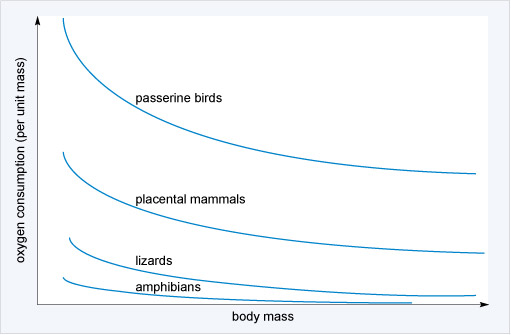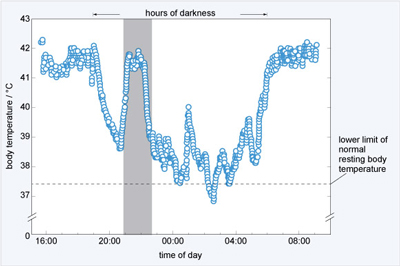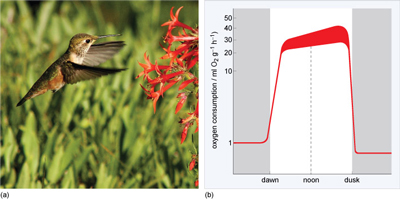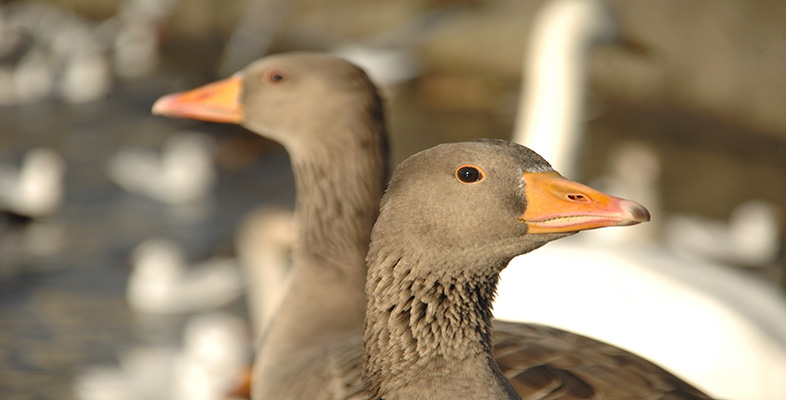4.1 Thermoregulation in migratory birds
Compared with mammals, birds have high basal metabolic rates, using energy at higher rates (Figure 21), and also higher body temperatures. Metabolic rates lie within a range of values between a minimum value, the basal metabolic rate (BMR), and the summit metabolic rate, when the bird is under the greatest physiological stress. Passerines tend to have higher BMR values than non-passerines. The smallest birds, hummingbirds, have the highest BMRs of all birds. In general, BMR is related to mass per unit surface area, with larger organisms, which have larger mass per unit area, expending less energy per unit mass than smaller ones.
In general, body temperatures of birds range from about 38 °C to 44 °C. Body temperatures of large flightless birds (e.g. emu and ostrich, Figure 22a) and some aquatic birds (e.g. penguins) are at the lower end of this range and within the range of mammals. The house sparrow (Figure 22b) has a body temperature of 43.5 °C.

To maintain temperature within the thermoneutral zone requires energy which for most organisms is a precious resource. Migratory birds in particular have tight energy budgets; to cover long distances without food means that migrating birds need to assimilate and conserve energy as much as possible before and/or during migration. The birds should avoid both heat and cold stress, as these use energy needed for flight, and they do so in a number of different ways.
In cases where individuals travel for long distances without drinking - for example, when crossing oceans or deserts - both thermoregulatory and osmoregulatory (water regulation) adjustments are required in order to conserve energy and water. Before migration, birds increase food intake, sometimes doubling their mass (pre-migratory fattening). Much of this food is stored as lipid, which, when metabolised, produces carbon dioxide and also water (which can contribute to water balance).
Some migrants enter regions where temperatures can become extreme. When crossing deserts, heat stress can become a problem due to the increased heat produced from persistent muscle contraction. To avoid overheating, many birds pant and some species may increase flight altitude to reach cooler conditions. However, some birds, especially small passerines, are unable to cross the Sahara Desert fast enough for a non-stop flight and must land during the heat of the day and rest to avoid overheating and dehydration.
At high latitudes and altitudes, ambient temperatures can be very low and so before migration, changes in feather covering and fat layers may be needed, reducing the energy used for thermoregulation and thus making more available for migration itself.
Some small passerines reach stopover sites that are very cold so that individuals are at risk of hypothermia. Some species have been observed to huddle at stopover sites and it has been suggested that this behaviour reduces energy expenditure and contributes to thermoregulation.
There is now increasing evidence that during and before migration, birds are able to lower their body temperature below ambient in order to conserve energy for the flight. Migrating passerines at stopover sites are thought to lower body temperatures by 8-10 °C during the night, conserving energy. Measurements of daily changes in body temperatures in migrating blackcaps appear to support this. Using radio telemetry at a stopover site at Midreshet Ben-Gurion, Israel, Wojciechowski and Pinshow (2009) showed that while at rest during a stopover, blackcaps can lower their body temperature by up to 10 °C below normal resting temperature at night and become hypothermic (Figure 23).

The effect of this is to reduce energy expenditure by as much as 30%. Blackcaps use protein as a fuel source during flight which is derived from the liver, gut, breast and leg muscles. Because of this, they arrive at stopover sites with atrophied liver and gut and during the initial stage of the stopover, their digestive efficiency is significantly lower than in the later part of the stopover. When they arrive therefore, birds may save energy by entering controlled hypothermia during cold nights until they are able to rebuild tissues and energy stores by foraging during the day.
It is now known that many bird species allow body temperature to drop below normal resting levels at night. For example, it has recently been suggested that lowered body temperature might be an important mechanism of energy conservation in migrating brent geese (Branta leucopsis, Figure 24).
However, none have been observed to lower it to the same extent as hummingbirds, which undergo deep, mammal-like torpor with body temperature decreasing by as much as 30 °C and BMR by a substantial amount, as shown in Figure 25a. Studies on rufous hummingbirds (Selasphorus rufus, Figure 25b) show that they use torpor to conserve energy that can be used later for migration. So, unusually, they go into torpor even when fat reserves are high and they also may go into torpor for periods during migration.

Activity 2 Studying the physiology of migration
Homeostasis introduced the processes concerned with the regulation of body temperature, using migratory birds as an example. How can physiological information be obtained from birds that migrate long distances? Lucy Hawkes discusses her research on bar-headed geese with Brett Westwood, in an interview recorded for the BBC. Listen to the interview and makes notes about the environmental limitations that the bird faces and the adaptations in both behaviour and physiology that enable it to migrate.
Transcript: Audio 1 Heart rate monitoring of migrating geese.
The bar-tailed godwit undertakes a very long migration. How does the bird prepare for the journey? Phil Batley studies migration and has been tagging the birds to follow their progress. He discusses his research in an interview with Philippa Forrester, which you should listen to now. What particular physiological strategy do the birds adopt to prepare for the flight?
Transcript: Audio 2 Satellite tagging of migrating bar-tailed godwits.
One way of countering problems associated with energy expenditure and thermoregulation in migrating birds is to have good orientation and navigational skills. This does not necessarily involve finding the shortest way to a destination; and in fact sometimes physiological difficulties may be avoided by taking a roundabout route. For example, favourable winds and meteorological conditions can conserve energy by reducing the costs of thermoregulation and birds require exceptional navigational skills to take advantage of this. The next section will explore these skills.


